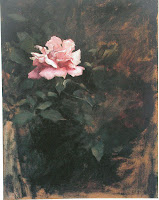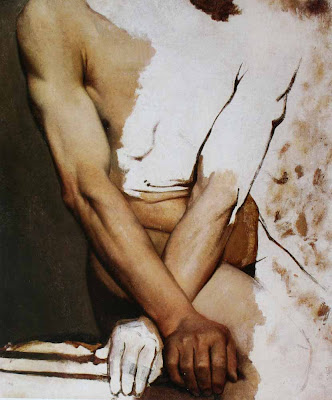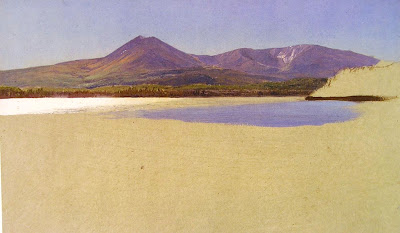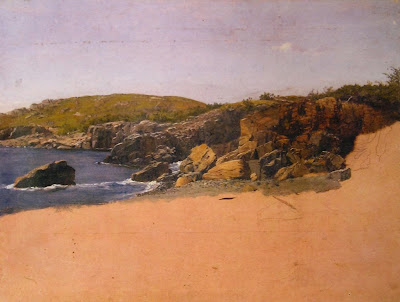 The idea is to loosely block in the whole picture immediately, ignoring detail. Scrub some tone over the whole canvas. Later on you can fine-tune the nuances of color and value and add the small touches, like the petals on the rose. This “overall approach” is a sensible way to work, but it’s not the only way to work.
The idea is to loosely block in the whole picture immediately, ignoring detail. Scrub some tone over the whole canvas. Later on you can fine-tune the nuances of color and value and add the small touches, like the petals on the rose. This “overall approach” is a sensible way to work, but it’s not the only way to work. This anonymous, undated, and unfinished figure study was produced by the school of Ingres using an unusual method called "area-by-area" painting.
This anonymous, undated, and unfinished figure study was produced by the school of Ingres using an unusual method called "area-by-area" painting.The artist proceeded in essentially two steps. First, the main lines and landmarks were carefully drawn with a brush. Then the painting was taken directly to finished effect at the first statement, proceeding across the canvas one area at a time.
 Here’s a plein-air study of Mount Katahdin by Frederic Church. He worked over a natural-toned paperboard, probably sealed with shellac. He began with an exact drawing of the mountain silhouette. The sky was painted next, very thinly, stippled and blended with the end of a big (probably badger-hair) brush. Then he rendered the delicate construction of the mountain and far shore using semi-opaque oils. He worked from top to bottom, left to right, like a human ink-jet printer.
Here’s a plein-air study of Mount Katahdin by Frederic Church. He worked over a natural-toned paperboard, probably sealed with shellac. He began with an exact drawing of the mountain silhouette. The sky was painted next, very thinly, stippled and blended with the end of a big (probably badger-hair) brush. Then he rendered the delicate construction of the mountain and far shore using semi-opaque oils. He worked from top to bottom, left to right, like a human ink-jet printer. In this unfinished study, Church captured the rocky coast of Maine in a similar way. On the right, you can see traces of his preliminary—and very precise—pencil drawing.
In this unfinished study, Church captured the rocky coast of Maine in a similar way. On the right, you can see traces of his preliminary—and very precise—pencil drawing.My suggestion is to follow what your painting teacher says while you’re in the classroom, but next time you’re painting from life on your own time, give this method a try and see if you like the results.
It’s not as hard as it looks. And it’s fast. The trick is to take your time getting the drawing right before you start in with paint, and then mix and render each area with full awareness of its relationship to other values.
What matters is not the method but the result.

Hi James,
ReplyDeleteIm surprised by this post, mainly its timing. I literally just finished reviewing Morgan Weistling's DVD ( Painting for the Impatient ). On the DVD, Morgan presents 2 methods of painting, the second being this exact approach, where he paints one area at a time to completion. He starts with an eye, and finishes it, then continues working his way out, basing all his measurements, and values on the finished eye.
Ive tried this approach, and I must say, I like it, However its not for the beginner, One really must be very confident with their drawing skills. In a since, your really just drawing with paint. One must pay close Beattention to the drawing, values and edges. I try not to think about the color to much, just values, and edges.
Best, Jason
I recently saw an exhibition in Berlin with drawings by Mathias Grünewald. There was also a watercolor painting by an anonymous artist, which showed one of the wings of the Isenheimer altarpiece in an unfinished state. It shows that Grünewald apparently began with the landscape and the secondary figures, finishing them one part at a time, while leaving a white spot in the centre, where the main figure (in this case St. Anthony) would be painted.
ReplyDeleteAgree with Jason.
ReplyDeleteI don't think it's for the beginner.
Secondly, as James stated, it's very good for working from life or copying from an example.
On the Dinotopia site there are some step-by-step examples of paintings that have been done in this way. Especially the marketplace painting puzzled me : how could he [James G.] start with that upper left corner and put it these dark reds right from the beginning? ...And from the beginning right !
But I assume now that he worked from a previous (color?) sketch or at least some very similar looking documentation.
(Is this correct?)
The first time I used this technique, really by accident, was on this rather quick horse sketch were I worked from square to square.
Though I do see flaws now, it only worked I guess because I copied it from a photograph, mind blank.
And also important : it made me feel calm and relaxed while drawing this, as I didn't have to search-and-erase constantly.
"Human ink jet printer" Very funny image. I think the blocking in approach is about common sense, it works out the compostition, although there's something really exciting about moving slowly across a canvas and revealing the details.
ReplyDeleteLove the Hearth painting below!
I come from the tradition of working all areas at once, and the first time I tried this area-by-area approach, it was a real mind-bender! I had a teacher who suggested this while in a workshop, and it was one of the hardest things I've ever done (art-wise.) It's probably harder for me, since I'm an alla prima painter.
ReplyDeleteR.H. Ives Gammell, my teacher's teacher, would have called this way of painting 'piecemeal seeing.'
ReplyDeleteI wonder, in looking at the Church's you posted, notice how the pencil sketch also stops where the paint does. This makes me think that he never intended to paint on those parts. Perhaps these are just some of the studies he'd do to influence a larger, studio project. Maybe all he needed of those scenes were the background mountains and mid-ground areas?
BTW, where did you come across such large scans of these Church's? They're magnificent!
I studied with a teacher who was dead against this approach.
ReplyDeleteHe always said to start with the masses, the largest first and work up the effect, and always be aware of the drawing.
I have done this as well it works well for small studies and still life studies. It is hard to do.
There is a great demo on this idea by the painter Douglas Flynt http://www.douglasflynt.com
I keep going back and forth on this one. I love this approach because it keeps me motivated during large and complicated paintings. After each stage, I can take a step back and say, "Okay, that's done."
ReplyDeleteI would add, however, that I only do this when I've previously worked out my color relationships in a quick study. In addition, I don't like to do this with faces because the complete emotion is only conveyed by the complete features.
Now it might get slightly off topic, so I beg your pardon.
ReplyDeleteThe fine blog journal entry concluded with the important words:
"What matters is not the method but the result."
Hmmm, does that include I am allowed to use china white and black in my watercolor paintings? A tricky question. For the "real" artists say: NO!
I think white and black are not necessarily needed, but...when I use them I can make my watercolors look much more like oil colors. And watercolors have the advantage that they are most easy to use, pencils are easy to clean, and the whole process doesn´t smell so bad. ;)
Plus, I carry the equipment easily around wherever I go.
Besides the material costs and the space I would need to store all my oil and acrylic painting equipment is an issue for me. I cannot afford to own my own studio.
Another thing: For me, working with watercolors is much easier in that way it is less strenous as in "I don´t have to think much about what I am doing, it just flows".
What is the opinion of you professionals artists about this if I may ask? Shall I stick more to some given rules or try new stuff with which I am (in some ways) more comfortable with?
Learn all the rules.
ReplyDeleteBreak them as necessary.
Adding white to watercolors makes them gouache. Nothing wrong with that.
ReplyDeleteAh. Maine, my homeland. It's nice to finally see an artist that's captured the rugged vitality of its unique landscapes.
ReplyDeleteThese are really helpful insights from all of you--thanks! Erik, I didn't have a tight color sketch for "Market Square" in Journey to Chandara, just a pencil tonal sketch
ReplyDeletewhich starts out the demo sequence that you mentioned. I knew it had to be dark to make the light head of the dinosaur read.
I learned from Steve Armes, an expert on academic methods, that this area-by-area method has also been called "shingling" and the "night shade" method, because it's like pulling down a night shade.
Great point that several of you made about how motivating and rewarding this method is right from the start, because the painting never goes through that cruddy phase we're all familiar with.
I have read Corot used the same method in his landscape paintings, finishing one section at a time.
ReplyDeleteI like that anonymous figure painting, where did you find that?
ReplyDeleteYour right about this way of painting being quicker, I'd rather work shape to shape on blank canvas than have to paint over a block-in that's "almost right".
Jeremy L: great to hear from you--I admire your work. The half-finished figure study came from a Sotheby catalog from a few years ago. They didn't know who did it, and just identified it as School of Ingres. I have no idea how many people worked this way.
ReplyDeleteTom, yes, I think there are some half-finished Corots like this. It's a great method for a scene where the light is changing fast, because you can nail a passage right away, rather than finding everything has changed between the layin and the finish.
Thanks, everybody for the great comments.
James, A very quick thanks for posting all your artistic thoughts, and insights into all things art (especially your tech insights). I think I learn somethin' new every time I stop in!
ReplyDeleteHi James - thanks for all your brilliant post. I'm grateful for all your generosity in sharing.
ReplyDeleteI'm a little late in discovering this post... but it is very relevant to me. Being self-taught, I have always painted 'area by area' and find it to be very dissatisfying. I think it is a technique that comes from an impatient approach to painting. I'm always wanting to see the finished detail as soon as possible otherwise I get bored of the painting. I'm going to try to find a way to wean myself off it as soon as possible.
I'm off to read some more of your posts.
Thanks again.
Shane
Actually, I'm working with two professors: one, teachme the big masses method, and the other one, the piece by piece method.
ReplyDeleteI'm not sure, but is possible that Tony Ryder uses that approach? he call it "FORM PAINTING"
http://www.theryderstudio.com/RSS/Form_Painting.html
And Jacob Collins? The GCA seems to teach that.
TERRIFIC blog. Is a pleasure to read it!!!
That's the way I paint and it's great. The trick is you must do an accurate drawing, just the basic shapes. And, you have to learn to read color and it's value.
ReplyDeleteAnd I also start at the top left corner and work my way across and down. People ask me how do you paint? Now I can use your human ink jet phrase. I love it!
Great blog. I come here often. Thanks for doing this, anderson
Hi, Anderson, Thanks for the comment, and glad you're enjoying the back posts.
ReplyDeleteAnderson and I are actually studying painting using the Carder Method which is an " a la Prima" method finishing one area at time. Anderson is light years ahead. There are some very unique aspects to the Carder Method including use of a Proportial Divider, Balancing your "whites" inside a shadow box with the outside lighting, use of a "colour checker" instrument of Mark's design etc.. I thought, since you are always interested in everything, if you haven't heard of it, you might want to check it out.
ReplyDeleteHere: http://www.thecardermethod.com/
This is really the ultimate in Alla Prima, because in true Alla Prima each stroke is carefully considered, laid down, and taken as the final statement without going back. So if you consider yourself a true Alla Prima painter, this is the way you do it.
ReplyDeleteSketch: Good point--that's a great way to think of alla prima, and I think you're right. From from "the start" to the "finish" immediately.
ReplyDeleteI work that way alot. Ive was introduced to it last year in college, except we call it "shape to shape". Its very slow and relaxing, it sometimes feels like the subject is doing all the work for you, and your getting all the benefits. I also found it great for improving the way you look at shapes and your general concentration.
ReplyDeleteBout time I start commenting on this blog. Its become one of my favourite and most looked forward to :D
Thanks for chiming in, Mark. That's interesting to hear you're using the same practice by another name.
ReplyDelete